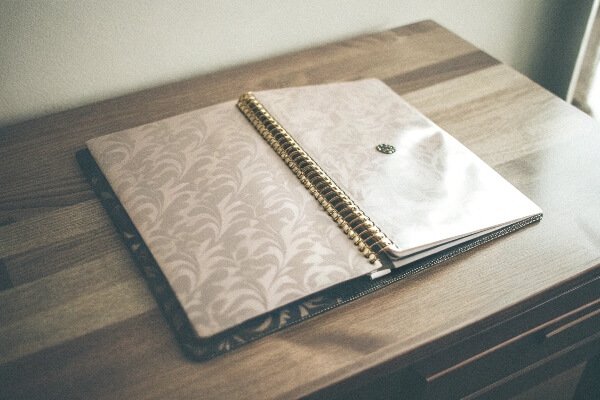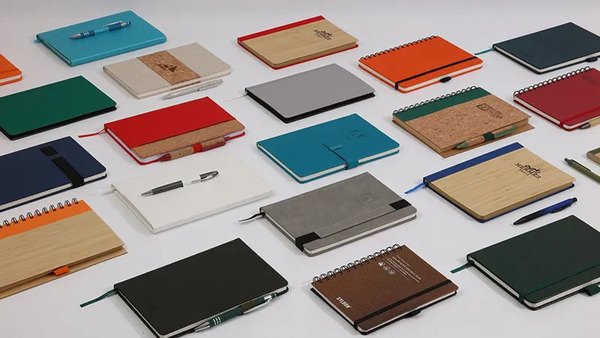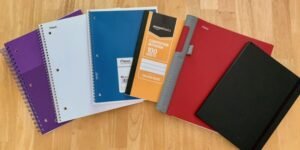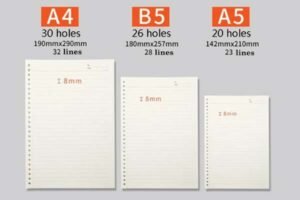
Choosing the right notebook can be tricky. You might pick one with too many pages and it becomes heavy. Or you choose one with too few and run out of space.
Student notebooks usually have 100-200 pages (50-100 sheets). Office notebooks often contain 80-120 pages (40-60 sheets). Personal journals typically feature 160-240 pages (80-120 sheets) for long-term use and durability.
The ideal page count is all about how you plan to use the notebook. A student needs enough paper to last a whole semester for one subject. An office professional needs a notebook that is light enough to carry to meetings all day. A person who journals wants a book that will hold a year's worth of thoughts. The purpose directly shapes the product. We consider these factors carefully when we design and manufacture notebooks for our clients.
At NotebookRing®, we have been making notebooks since 2006. We understand that one size does not fit all. We help our clients decide on the perfect page count for their specific needs. This could be a slim notebook for a corporate event or a thick journal for a bookstore. We make sure the final product is just right for its intended user.
How many pages in a student notebook?
Students need notebooks that work for their classes.
The page count must balance the need for enough writing space with the need for portability from class to class.
A standard single-subject student notebook has between 100 and 200 pages (which is 50 to 100 sheets of paper). For multi-subject notebooks, the page count can go up to 200 pages or more, with dividers.

Single-Subject vs. Multi-Subject Notebooks
The most common choice for students is the single-subject spiral notebook. It usually has around 70-100 pages. This is often enough for a single class for one semester. But for classes with a lot of notes, like history or literature, a student might need more pages. Multi-subject notebooks are a popular solution. They combine 3, 5, or even 6 subjects into one book. These notebooks are thicker. They can have 200 to 300 pages, separated by pocket dividers. This helps students stay organized without carrying many different books.
Key Factors for Student Notebooks
Several things determine the best page count for a student.
- Course Requirements: A math class may require fewer pages than an English class where students write long essays.
- School Schedule: A school on a quarter system might need fewer pages per notebook than a school with longer semesters.
- Note-Taking Style: Some students write small and use both sides of the page. Others write large and use only one side.
As a manufacturer, we offer options to meet these needs. For example, we create bulk customized notebooks for educational institutions. These might be simple 50-page notebooks with a school logo and tear-proof reinforcement for heavy use. We also provide paper upgrades from our standard 80gsm to a thicker 100gsm paper for just $0.07 extra per book, which helps prevent ink from bleeding through.
| Use Case | Recommended Page Count | Common Binding |
|---|---|---|
| Single Subject (e.g., Math) | 70-100 Pages | Spiral, Sewn |
| Heavy Note-taking (e.g., History) | 120-150 Pages | Spiral, Sewn |
| Multi-Subject (3-in-1) | 150-200 Pages | Spiral with Dividers |
| Lab/Practical Work | 100 Pages (with grid/graph paper) | Spiral |
Common page counts in office or meeting notebooks
In a business setting, a notebook is a tool for productivity. It needs to look professional and be easy to carry around. This influences the typical page count.
Office and meeting notebooks usually contain between 80 and 120 pages (40 to 60 sheets). This size provides enough space for notes without making the notebook heavy or bulky for carrying between meetings.

Portability is a Priority
Professionals are always on the move. They go from their desk to a conference room, to a client's office, or on a business trip. A thick, heavy notebook is not practical. A slimmer notebook with around 96 pages (48 sheets) is a very common choice. It fits easily into a laptop bag or portfolio. It also looks sleek and professional when placed on a conference table. That is why many of our corporate clients, like a Silicon Valley tech company we worked with, choose this middle-ground page count for employee onboarding kits.
Customization for Corporate Identity
For businesses, notebooks are also a branding tool. We specialize in creating custom notebooks for corporate gifts.
Common Office Notebook Formats
Here are some typical page counts for different professional uses:
| Notebook Type | Typical Page Count | Primary Use | Recommended Feature |
|---|---|---|---|
| Meeting Notebook | 60 - 100 pages | Taking notes during meetings | Perforated pages for easy tearing |
| Project Planner | 120 - 150 pages | Organizing a single project | Indexed pages, task list format |
| Executive Notebook | 96 pages | Daily notes, professional gift | High-quality paper, hot-stamped logo |
| Daily To-Do List | 50 - 80 pages | Quick notes and tasks | Small size (A6 or B6) |
We frequently produce business sets with a hot-stamped logo. A notebook paired with a metal binder and a brass bookmark makes a great gift. For these sets, a page count of 80 to 120 pages is ideal. It feels substantial without being excessive. One of our clients, a corporate gift company in Singapore, needed small batches of 300 sets. We were able to help them with custom laser engraving on metal binders, a service many suppliers do not offer for smaller orders.
Page counts for bullet journals or diaries
Journals and diaries are very personal. Users want a notebook that can hold their thoughts for a long time. This means they often need more pages than a standard notebook.
Bullet journals and diaries usually have between 160 and 240 pages (80 to 120 sheets). This higher page count allows the user to write for six months, a full year, or even longer.

The Importance of Paper and Binding
When a notebook has many pages, the quality of the materials is very important.
High-Quality Paper
With 200 or more pages, you need paper that resists ink bleeding and ghosting. No one wants their writing on one page to be visible on the other side. This is why we offer premium paper options. Our standard is a high-quality 80gsm acid-free paper. But for journals, many clients upgrade to 100gsm or even 120gsm paper. This ensures a great writing experience. We also offer specialty papers like Japanese Tomoe River paper, which is thin but very resistant to ink.
Durable Binding
A thick notebook requires a strong binding to hold it together. The binding also affects how the notebook opens. For journals, being able to lay the notebook completely flat is a huge advantage. Our sewn glue binding is perfect for this. It is strong and allows the notebook to open 180 degrees. This was a key feature for a German chain bookstore we worked with. We developed a series of plant atlas notebooks for them using this bare spine binding method, which became very popular.
Custom Features for Journalers
Journaling is a creative process. We support this by offering many customization options.
- Inner Page Formats: Dotted grids are the most popular for bullet journaling. We also offer grid, line, and blank formats. We can even add page numbers or custom logos to each page.
- Cover Designs: We can create covers with hot stamping, embossing, or laser engraving to make the journal unique.
- Accessories: We can add features like elastic bands, ribbon markers, and back pockets to hold small items.
Page ranges for loose-leaf and spiral notebooks
Some notebooks offer more flexibility. Spiral and loose-leaf notebooks allow you to add, remove, or rearrange pages. Their capacity is different from a standard bound book.
Spiral notebooks can have anywhere from 70 to over 200 pages. The capacity of a loose-leaf binder is determined by the ring size. For example, a standard 1-inch binder can hold about 175-200 sheets.

Spiral Notebooks: The Lay-Flat Champion
Spiral notebooks are a favorite among students and professionals. Their biggest advantage is that they can be folded back on themselves. This saves desk space and provides a firm writing surface. Our patented "seamless coil" technology creates a 360-degree smooth touch. This means the coil will not snag on your clothes or bag. We can produce spiral notebooks with a wide range of page counts to suit any need.
Loose-Leaf Binders: Ultimate Flexibility
Loose-leaf binders offer the most freedom. You are not limited by a set page number. You can add paper as you need it. This system is great for organizing different subjects or projects. We are experts in manufacturing the metal binder mechanisms. We make high-quality 304 stainless steel binder rings that are durable and rust-proof. Our binders are compatible with international standards like Filofax (6-hole) and Kokuyo Campus (20/26-hole).
Binder Capacity Guide
The size of the rings determines how many pages you can fit.
| Ring Diameter | Approximate Sheet Capacity (20lb/75gsm paper) |
|---|---|
| 0.5 inch | 100 sheets |
| 1 inch | 175-200 sheets |
| 1.5 inch | 275-300 sheets |
| 2 inch | 375-400 sheets |
| 3 inch | 550-600 sheets |
Hardcover vs softcover notebook page counts
The cover of a notebook does more than just protect the pages. It can also influence the notebook's page count and overall feel.
Hardcover notebooks are built for durability and often have higher page counts, usually 160 pages or more. Softcover notebooks are more flexible and lighter, typically ranging from 60 to 120 pages.

Hardcovers: Designed to Last
A strong, rigid hardcover provides excellent protection for the pages inside. This sturdy construction can support a larger and heavier block of paper. Because of this, hardcovers are the preferred choice for journals, planners, and any notebook intended for long-term use. The investment in a hardcover makes sense when it is protecting 200+ pages of valuable notes or memories. Our hardcover options can be customized with cloth, vegan leather, or printed paper, and finished with hot stamping or embossing.
Softcovers: Lightweight and Flexible
Softcover notebooks are light and bendable. Their flexibility makes them easy to slip into a pocket or a full bag. They are perfect for shorter-term uses, such as a single project, a specific class, or a travel journal. A lower page count, like 64 or 96 pages, keeps the notebook slim and portable. We even offer environmentally friendly options for softcovers, such as covers made from bagasse fiber or degradable PP plastic. This gives our clients a lightweight and sustainable choice.
Conclusion
The right page count depends on the notebook's purpose. Students need more pages for their studies. Professionals need portable notebooks for meetings. And journalers need durable books with many pages. At NotebookRing®, we help you find the perfect balance for your needs.






